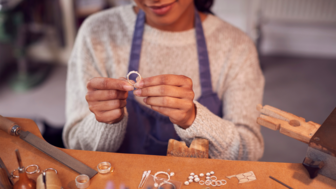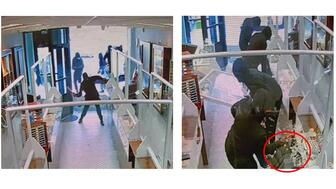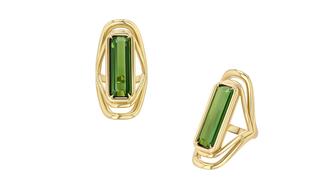The National Retail Federation expects retail sales growth to return to pre-pandemic levels as consumers continue to face inflation.
Straight Talk About Running an Online Store
At Conclave last week, “Technology Therapist” Jennifer Shaheen shared her essential list of e-commerce best practices for 2017.
Los Angeles--At AGS Conclave last week, “Technology Therapist” Jennifer Shaheen promised to give it to retailers straight.
In her session “Straight Talk: What It Really Takes To Run an Online Store,” Shaheen, who founded her digital marketing firm Technology Therapy Group in 1997 when the field was brand new, laid out her essential list of e-commerce best practices for 2017.
Citing data that said by 2020, 40 percent of luxury purchases will be made online, Shaheen stressed the importance of continuously evolving one’s e-commerce strategy.
“It’s a journey,” she explained. “Your work is never done.”
Here are some keys to developing an e-commerce strategy today, according to Shaheen.
1) Be detailed with your product descriptions.
When it comes to fine jewelry, information is key.
Consumers need as much detail as possible about the materials and sizing of any given piece of jewelry. That becomes even more important with watches, which attract connoisseurs, so make sure all watch specs are fully represented.
The extra time spent crafting a clear and in-depth product description will translate to higher trust and higher sales. Not having enough information is a deal breaker.
2) Don’t forget to mention sizing options.
If a ring or bracelet can be sized, indicate that in the product description. Shaheen recommended that jewelers offer free resizing for life. Not only does that provide the kind of personal attention that is just as critical to e-commerce as it is to a brick-and-mortar store, it also creates a lifelong relationship between store and customer.
3) When it comes to pictures, be sure to include some images to scale.
Shaheen stressed that in addition to regular flat product lays, it’s imperative to provide images of jewelry worn by a person for a sense of scale. Without an idea of how large an item is in comparison to its owner, a consumer can’t visualize wearing it.
If the idea of hiring someone to shoot product on a model in addition to standard product shots is daunting, it’s OK to take pictures of the jewelry on yourself or one of your employees.
Just remember to shoot the image in natural light if possible and have the images retouched.
A post shared by hodinkee (@hodinkee) on Apr 6, 2017 at 8:16am PDT
4) It’s OK to get creative with your images.
“You’re selling a lifestyle,” said Shaheed, who recommended keeping imagery consistent across all platforms, from e-commerce to social media.
When posting an image of a bracelet on a person’s wrist
As long as the image fits in with your store’s overall aesthetic, then it’s worth it to create some visual interest.
5) Images should change seasonally.
For your home page, make sure that you’re posting new images once a season, or ideally more, adjusting for important occasions and holidays.
New content is imperative, and you’ll need it for social media as well.
6) The zoom function is your friend.
Fine jewelry represents a significant luxury purchase. Consumers are becoming ever more comfortable shopping online, in part because they expect to be able to see product up-close.
The zoom function will let customers check out the miniscule details of a piece of jewelry; this is key to online shopping confidence.
7) Keep the experience smooth.
When scrolling through your store’s products online, customers hate jumping from one page to the next. Instead of having multiple pages, keep all products on one page, letting more items load as users scroll down.
8) That goes for mobile too.
Multiple pages of product listings on mobile is also a no-go. Instead, stick with the scroll down rule.
Most importantly, make sure essential buttons like “add to cart” are located in the “thumb zone,” the area easiest to reach with your thumb.
9) Try a GIF.
If you’re utilizing videos in your e-commerce store, think about using a GIF for the mobile version. Unlike videos, a GIF will auto-play on a smartphone.
10) Consider your e-commerce store your second store location.
It needs to be invested in as if it’s another brick-and-mortar location. A completely custom-built website will likely cost $15,000 to $30,000 or up, Shaheen said.
Using a pre-existing e-commerce point-of-sale system like Shopify or WooCommerce will cut this cost.
11) Shopify might be the way to go, if only for Instagram.
If you’re deciding between point-of-sale software, remember that Instagram is launching its shopping function with only two designated partners, and one of those happens to be Shopify.
Shopping directly through social media is the next step in retail, and it could pay off to be tuned into this early.
12) If you’re not ready to make a serious commitment, consider your e-commerce store more of a pop-up.
Rather than hiring a developer to create a completely custom e-commerce set-up, you can utilize a pre-existing platform like WordPress and test it out.
Make a pared-down, simpler version of an e-commerce store and keep it to under 100 SKUs.
13) Consistently update your inventory.
Whether you’ve invested in a serious e-commerce branch of your business, or you’re testing out a pop-up version, if you don’t add new product every couple of weeks, you won’t see a return on investment.
A lack of new products equates to a total lack of interest for consumers. New product to see will keep customers coming back.
14) Hate creating accounts? So do your customers.
If shopping in your online store requires that customers create an account, you might lose them. The easier the purchasing experience is, the better.
15) No one likes shipping fees either.
By building them into the cost of an item, or absorbing them, retailers have made the buying process that much easier.
16) Be prepared to ship quickly.
Shaheen said that retailers should only list items in their store if they are able to send them out within 48 to 72 hours of an online purchase.
If an item is made to order, be sure that that information is listed clearly in the product description so customers understand the wait time up front.
17) Make returns totally transparent.
Speaking of being up front, don’t bury any important details in the fine print.
Think about displaying your return policies right on your home page where they are extremely visible. Today’s online shopper wants transparency; this is how you create loyalty.
18) A/B testing can help you understand your online audience.
Certain third-party companies can test elements of your website’s effectiveness with online shoppers.
For example, if you’re torn on a design element like a color scheme, A/B testing will gather analytics from random groups of shoppers and see which of two options they liked more.
19) Pay attention to analytics.
Google Analytics is making it easier than ever to see who is shopping with you, so take advantage of it.
Pay particular attention to bounce rates, meaning customers who come to a certain page of your e-commerce store and immediately leave or “bounce out.” High bounce rates will indicate where you need to make changes to your site.
20) Don’t forget the self-purchasing female consumer.
Shaheen said that said 85 percent of all online consumer purchases today are made by women.
21) The reviews for your physical store location are going to remain important.
Not only will they affect your brick-and-mortar business, fine jewelry online shoppers will likely do their research and check out reviews, particularly before their first purchase with you.
22) Add that extra touch.
Shopping online needs to feel the same as it does when receiving great customer service in person.
Shaheen suggested including a cute card in an item’s packaging asking customers to share their purchases on social media and tagging your store or using certain hashtags.
23) Be realistic.
Conversion rates for online shopping are, on average, about 3 percent across all industries.
In fine jewelry in particular, Shaheen said they are between 3-5 percent with the companies with which she works.
Don’t be discouraged by those numbers. Research shows that consumers are shopping across multiple platforms, oftentimes looking online before going into a store to make a final purchase.
The online audience is only growing. Stick with it.
The Latest

The 4-carat, old mine brilliant-cut diamond engagement ring was co-designed by Willis and New York City-based brand Karina Noel.

Rio Tinto unearthed the diamond at its Diavik mine in Canada’s Northwest Territories.

Bench jewelers spend years honing their skills, Jewelers of America’s Certification validates their talents.

The multisensory experience, open April 8-13, will feature the brand’s silver creations among dream-like scenes of natural landscapes.


The virtual event will take place April 7 at 3 p.m.

The pieces in “Animali Tarallo” portray animals from stingrays to elephants through portraits and interpretations of their patterns.

Natural diamonds mean more than lab-grown, but when every cut is ideal, they all look the same. Customers want more—Facets of Fire delivers.

Parent company Saks Global said the iconic location will be open through the holiday season as it decides what to do with the space.

Ronald Winston, son of Harry Winston, donated the diamonds to the Smithsonian National Museum of Natural History in Washington, D.C.

The educational event will take place in Charlotte, North Carolina, this May.

The independent jeweler first opened its doors in 1888.

The layoffs come amid the TV shopping channel’s efforts to restructure and focus on live shopping through social media.

The debut event will take place in Miami’s Coconut Grove neighborhood this fall.

The roundtable will take place May 17 ahead of the trade show’s welcome dinner.

The “Peanuts x Monica Rich Kosann” collection features the comic strip’s classic vocabulary across 10 bracelet designs.

Three industry experts dive into the complexities of the material often marketed as an “ethical” alternative for metal in jewelry.

Diamonds are not only one of the most prominent gemstones, but the birthstone for those born in April.

The Utah-based company known for making wedding bands has acquired Doubloon Golf.

The longtime luxury executive led one of LVMH’s watch brands, TAG Heuer, for 12 years before taking over Bulgari in 2013.

Authorities said the robbers fled with jewelry and 70 Rolex watches, later taking pictures of themselves posing with big stacks of cash.

Lotus Gemology founder Richard W. Hughes has translated Heinrich Fischer’s 1880 book “Nephrit und Jadeit” from its original German.

The ring's design features contrasting lines influenced by work from architecture-inspired photographer Nikola Olic.

The Conference Board’s index fell as consumers continued to worry about the impact of tariffs, the labor market, and the price of eggs.

However, two medieval jewels surpassed estimates at Noonans Mayfair’s recent jewelry auction in London.

The Oscar-nominated actor debuted in the campaign for the new “Top Time B31” collection, which introduced Breitling’s Caliber B31.

The Congress is scheduled to take place May 19-22 in Brasilia, Brazil.




























